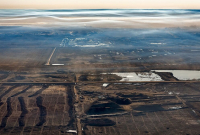Support strong Canadian climate journalism for 2025
Nearly 50 years after the opening of Canada's first major oilsands mine, the site on the banks of Alberta's Athabasca River is an epicentre of energy, teeming with bustling workers amid signs of its pioneering past and cutting-edge future.
One of the mine's upgraders — opened in September 1967 — turns heavy, sticky oilsands bitumen into light synthetic oil to ship to market. In the very near future, the ore containing that bitumen may be hauled by driverless trucks currently undergoing testing on site.
"Technology is a wonderful thing," said Bill Bruce, general manager of mine production at the Suncor Energy Base Plant, located 24 kilometres north of Fort McMurray.
"In some cases people are afraid of it, but if you don't evolve as an organization or as people, you will be left behind."
Canada's oilsands are at a crossroads. Estimated to contain 166 billion barrels of crude recoverable with today's technology, they are also loathed by environmentalists who fear their development will accelerate climate change. Other challenges include a carbon pricing regime, a cap on emissions, pipeline constraints and a flood of U.S. shale oil production that is weighing on prices.
Despite growing environmental outcry, oilsands production is expected to continue to grow in the years ahead, and so the industry is developing unique technologies to extract more black gold more efficiently while lessening its environmental footprint.
At the mine that began as the Great Canadian Oil Sands project, where the air is filled with the occasional muffled "thump" of bird deterrent cannons, Suncor staff are implementing practices aimed at keeping the operation competitive in an era of lower oil prices and tougher public scrutiny.
Bruce, who began working at the mine as a 19-year-old some 37 years ago, has seen the evolution in mining from the awkward original 850-tonne bucket-wheel excavators to more nimble trucks and shovels. He's a big fan of the latest incarnation — driverless ore-hauling trucks — that are helping open up a new mine extension. The trucks have an extra antenna and bumper-mounted radar equipment, but are otherwise identical to those with people at the wheel.
"The trucks are like elephants," said Nicolas Bouliane, head of the autonomous truck pilot project, in an interview at the mine's office complex.
"They're very careful about stepping on anything."
He said the six 272-tonne capacity Komatsu trucks follow their pre-designated tracks, stopping when they detect an obstacle, and are therefore entirely predictable, unlike human drivers.
Bouliane said no decision has been made on whether to expand use of the driverless technology at existing operations or at the Fort Hills mine, which is expected to start up later this year. Although the technology has a strong safety record, data is to be collected over a three-year period to assess the advantages of fuel efficiency, production and maintenance by going driverless.
On a well pad at the MacKay River project 60 kilometres northwest of Fort McMurray, Suncor is testing the injection of carbon dioxide into oilsands wells to reduce the amount of steam required to keep the bitumen flowing, a technique considered more environmentally friendly.
"In theory, half the carbon dioxide injected will stay in the ground," said Gary Bunio, general manager of strategic technology, standing on a gravel well pad site near a carbon dioxide tank.
If the testing is successful and economical, he said Suncor could eventually capture CO2 at its upgraders and use it for another project, growing production while reducing greenhouse gas emission intensity.
Suncor and its partners are also testing the results of a pilot project that used warm solvent to recover some 125,000 barrels of bitumen with no water and much lower emissions in anticipation of potential commercial use.





Comments